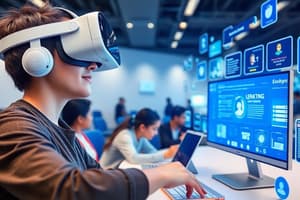Podcast
Questions and Answers
What is the primary purpose of educational technology?
What is the primary purpose of educational technology?
To improve learning, teaching, and education management.
What are some examples of educational software?
What are some examples of educational software?
Educational games, simulations, and multimedia resources.
What is one of the benefits of using mobile learning in education?
What is one of the benefits of using mobile learning in education?
Increased accessibility to education
What is a potential challenge of implementing educational technology in the classroom?
What is a potential challenge of implementing educational technology in the classroom?
How can Web 2.0 tools be used in education?
How can Web 2.0 tools be used in education?
Flashcards are hidden until you start studying
Study Notes
Educational Technology
Definition
- Educational technology refers to the use of technology to improve learning, teaching, and education management.
- It encompasses a wide range of tools, platforms, and systems that support learning, communication, and collaboration.
Types of Educational Technology
- Learning Management Systems (LMS): software applications that facilitate online learning, such as Moodle, Blackboard, and Canvas.
- Virtual Learning Environments (VLEs): online platforms that simulate a physical classroom, such as Second Life and OpenSim.
- Educational Software: programs that provide instructional content, such as educational games, simulations, and multimedia resources.
- Mobile Learning: the use of mobile devices, such as smartphones and tablets, to access educational content and participate in learning activities.
- Web 2.0 Tools: online applications that facilitate collaboration, communication, and content creation, such as blogs, wikis, and social media.
Benefits of Educational Technology
- Personalized Learning: technology allows for tailored learning experiences that cater to individual students' needs and abilities.
- Increased Accessibility: technology provides access to education for students with disabilities, remote or rural areas, and those with conflicting schedules.
- Improved Engagement: technology can increase student motivation and engagement through interactive and immersive learning experiences.
- Enhanced Collaboration: technology facilitates communication and collaboration among students, teachers, and other stakeholders.
- Cost-Effective: technology can reduce costs associated with traditional learning methods, such as textbooks and travel.
Challenges of Educational Technology
- Digital Divide: unequal access to technology and internet connectivity can exacerbate existing inequalities.
- Technical Issues: technical problems can disrupt learning and teaching, such as hardware or software failures.
- Pedagogical Challenges: integrating technology into teaching practices requires significant professional development and support.
- Cybersecurity: educational institutions must ensure the security and privacy of student data and online learning environments.
- Equity and Inclusion: ensuring that technology is accessible and usable by all students, regardless of their abilities or disabilities.
Educational Technology
Definition
- Educational technology uses technology to improve learning, teaching, and education management.
- It encompasses a wide range of tools, platforms, and systems that support learning, communication, and collaboration.
Types of Educational Technology
Learning Management Systems (LMS)
- Software applications that facilitate online learning, e.g., Moodle, Blackboard, and Canvas.
Virtual Learning Environments (VLEs)
- Online platforms that simulate a physical classroom, e.g., Second Life and OpenSim.
Educational Software
- Programs that provide instructional content, e.g., educational games, simulations, and multimedia resources.
Mobile Learning
- Use of mobile devices, such as smartphones and tablets, to access educational content and participate in learning activities.
Web 2.0 Tools
- Online applications that facilitate collaboration, communication, and content creation, e.g., blogs, wikis, and social media.
Benefits of Educational Technology
- Personalized Learning: technology allows for tailored learning experiences that cater to individual students' needs and abilities.
- Increased Accessibility: technology provides access to education for students with disabilities, remote or rural areas, and those with conflicting schedules.
- Improved Engagement: technology can increase student motivation and engagement through interactive and immersive learning experiences.
- Enhanced Collaboration: technology facilitates communication and collaboration among students, teachers, and other stakeholders.
- Cost-Effective: technology can reduce costs associated with traditional learning methods, such as textbooks and travel.
Challenges of Educational Technology
- Digital Divide: unequal access to technology and internet connectivity can exacerbate existing inequalities.
- Technical Issues: technical problems can disrupt learning and teaching, such as hardware or software failures.
- Pedagogical Challenges: integrating technology into teaching practices requires significant professional development and support.
- Cybersecurity: educational institutions must ensure the security and privacy of student data and online learning environments.
- Equity and Inclusion: ensuring that technology is accessible and usable by all students, regardless of their abilities or disabilities.
Studying That Suits You
Use AI to generate personalized quizzes and flashcards to suit your learning preferences.




